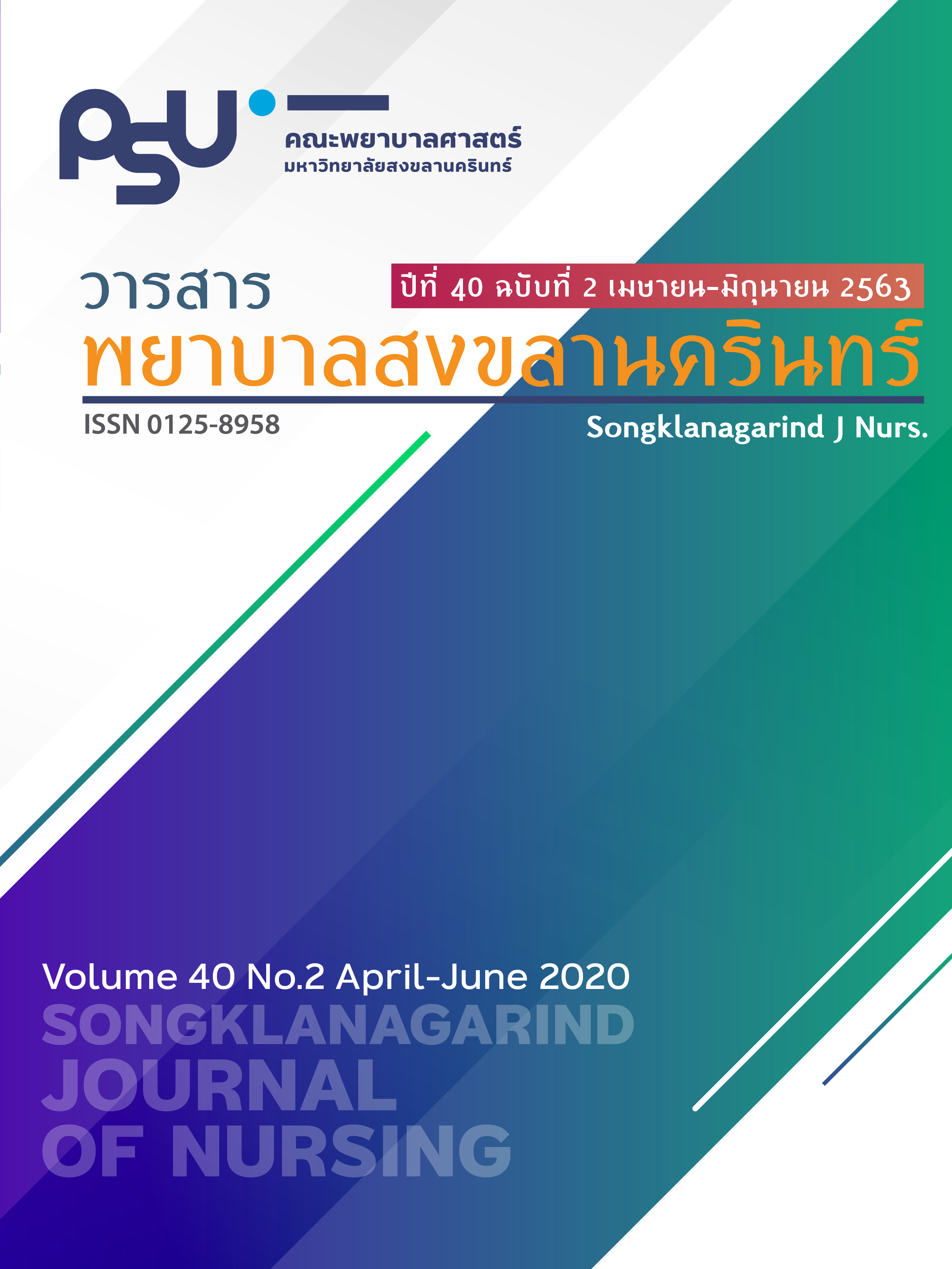Evaluation of the Psychometric Properties of Self-Efficacy in Performing Maternal Role for First Time Pregnant Adolescents in Indonesia
Main Article Content
บทคัดย่อ
The aim of this study was to evaluate the psychometric properties of self-efficacy in performing the maternal role scale for first time pregnant adolescents in Indonesia (SEPMRS-Indonesia). The conceptual framework of this study was based on Bandura’s self-efficacy theory, Rubin’s concept of the maternal role, and a review of the relevant literature. Interviewing were conducted among twelve Indonesian adolescents who were experiencing their first pregnancy. The first draft of seventy-eight items was validated by five experts, sixty-three items remained and were examined for clairty by five of the Indonesian interviewees.
Exploratory factor analysis (EFA) and known group techniques were conducted to assess the construct validity. EFA yielded two factors of 60 items which explained 58.85% of the total variance, namely: (1) being able to perform essential activities during pregnancy, and (2) maintaining health and happiness during their pregnancy. The result of known group technique showed a significant mean difference in the scores of SEPMRS-Indonesia between pregnant adults and pregnant adolescents with a first-time pregnancy (p < .01). Reliability analysis was performed including internal consistency and test-retest. The range of overall Cronbach’s alpha coefficients were .97 to .98. The test-retest reliability of the sixty items SEPMRSIndonesia was at an acceptable level (r = .99), meaning this scale is a reliable tool for measuring the performing the maternal role of first time pregnant adolescents. In conclusion, nurses can apply this scale for screening the maternal confidence performance level of pregnant women and identifying appropriate strategies for empowering them to effectively perform their maternal role.
Article Details
เอกสารอ้างอิง
AlBuhairan F, Areemit R, Harrison A, et al. Adolescent psychosocial development and evaluation: Global perspectives. Complementary Pediatrics. 2012; 179-201. Available from www.intechopen.com.
Pillitteri A. Maternal and child health nursing: Care of the childbearing and childrearing family. Philadelphia: Liipincott Williams & Wilkins; 2014.
Meyers SE. Maternal role & high-risk pregnancy experience with antepartum hospitalization. The University of Texas. 2010. Available from https://search.proquest. com/docview/856589959.
Ricci SS, Kyle T, Carman S. Maternity and pediatric nursing (3 rd ed.). Philadelphia: Lippincott Williams & Wilkins; 2017.
Mercer RT, Ferketich SL. Maternal-infant attachment of experienced and inexperienced mothers during infancy. Nurs Res. 1994; 43(6): 344-51.
Rubin R. Maternal identity and the maternal experience. New York: Springer; 1984.
Rachmawati JK. Acceptance of premarital teenage pregnancy. Univ of Edu of Indonesia. 2014. Avaibale from http://repository.upi.edu/6359/4/S_PSI_0906283_Chapter%201.pdf. Indonesia.
WHO. Preventing early pregnancy and poor reproductive outcomes among adolescents in developing countries. 2017. Available from: http://www.who.int/reproductivehealth/publications/adolescence/9789241502214/en/.
Mirghafourvand M, Charandabi SM, Jafarabadi MA, et al. Psychometric properties of maternal self-efficacy questionnaire in a population of Iranian mothers. J Child Fam Stud. 2016; 25(10): 2966-71.
Weglicki LS. The development and testing of an instrument to measure maternal confidence in African American pregnant teens. 1999. The University of Michigan. Available from https:// deepblue.lib.umich.edu/handle/2027.42/132032.
Dennis CL, Heaman M, Mossman M. Psychometric testing of the breastfeeding self- efficacy scale-short form among adolescents. J Adolesc Health. 2011; 49(3): 265-71. doi: 10.1016/j.jadohealth.2010.12.015
Guimond AB, Wilcox MJ, Lamorey SG. The early intervention parenting self-efficacy scale (EIPSES): Scale construction and initial psychometric evidence. J Early Interv. 2008; 30: 295-320.
Secco ML. Assessment of the psychometric features of the perceived maternal competence (PMC) scales with a sample of adolescent mothers. 1997. The University of Manitoba. Available from https://mspace.lib.umanitoba. ca/xmlui/handle/1993/801.
Kaiser MM. Transition to motherhood in adolescence: The development of the adolescent prenatal questionnaire 2002. The University of Nebraska. Available from https://www.ncbi.nlm.nih.gov/pubmed/14742107.
Bandura A. Self-efficacy: Toward a unifying theory of behavior change. Psychol Rev. 1997; 84(2): 191-215. doi: https://doi.org/10.1037/0033295x.84.2.191
DeVellis RF. Scale development: Theory and application (4 th ed.). Thousand Oaks, CA: Sage Publication; 2017.
Waltz CF, Strickland OL, Lenz ER. Measurement in nursing and health research 5 th ed. New York: Springer Publishing Company; 2017.
Munro BH. Statistical methods for health care research 5 th ed. Philadelphia, PA: Lippincott Williams & Wilkins; 2005.
Hasson D, Arnetz B. Validation and findings comparing VAS vs Likert Scales for psychosocial measurements. Int Electron J Health Educ. 2005; 8: 178-92.
Jamieson S. Likert scales: How to abuse them. Medical Education. 2002; 38(12): 1217-8.
Nunnally JC, Bernstein IH. Psychometric theory (3 rd ed.). New York: McGraw-Hill; 1994.
Rummel RJ. Applied factor analysis. Evanston, IL: Northwestern University Press; 1970.
Yong AG, Pearce SA. Beginner’s guide to factor analysis: Focusing on exploratory factor analysis. Tutor Quant Methods Psychol. 2013; 9(2): 79-94.
Rummel RJ. Applied factor analysis. Evanston, IL: Northwestern University Press; 1970.
Pett M, Lacke N, Sullivan J. Making sense of factor analysis: The use of factor analysis for instrument development in health care research., Thousand Oaks, CA: SAGE Publications; 2003.
Bandura A. Self-efficacy: The exercise of control. New York, NY: Freeman; 1997.
Erika., Nongnut B, Chunuan S. The maternal role performance among Indonesian pregnant adolescents. Songklanagarind J Nurs. 2017; 37 (Supplement) 80-8.
Cinar N, Menekse D. Affects of adolescent pregnancy on health of baby. Open J Pediatr Neonatal Care. 2017; 2(1): 012-23.
Mukhopadhyay P, Chaudhuri RN, Paul B. Hospital-based perinatal outcomes and complications in teenage pregnancy in India. J Health Popul Nutr. 2010; 28(5): 494-500. doi: 10.3329/jhpn.v28i5.6158
Chena XK, Wen SW, Fleming N, et al. Walker MC. Increased risks of neonatal and post neonatal mortality associated with teenage pregnancy had different explanations. Journal of Clinical Epidemiology. 2008; 61(7): 688-94. doi: 10.1016/j.jclinepi.2007.08.09


